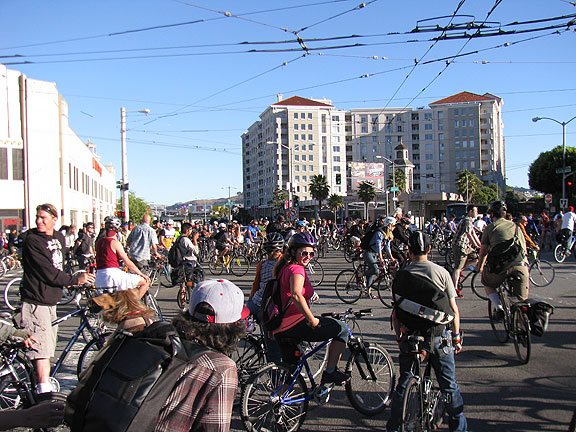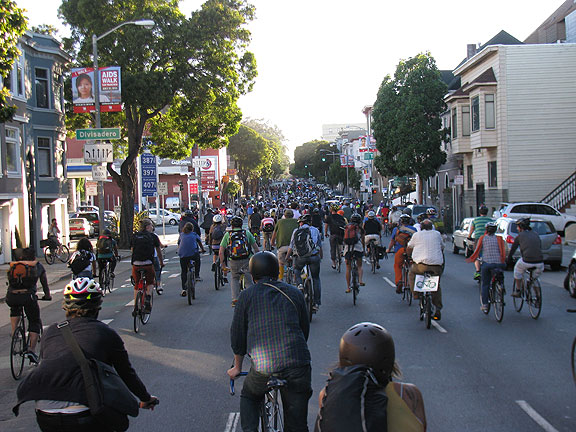In September 2012, to accompany the release of Shift Happens!: Critical Mass at 20, we published excerpts of Critical Mass history and its effects from several cities. We’re picking it back up again, because there is so much more to highlight (17 more towns and cities!), and also because book co-editors Chris Carlsson and LisaRuth Elliott will be appearing in a fun evening about the book at San Francisco’s Booksmith next week. On Friday, November 15, The Literary Foolery Cabaret will highlight Shift Happens! along with treating attendees to music, storytelling, and a unicycle duo! Check out the evening of “booze, books, bicycles, and burlesque” if you’re in the San Francisco Bay Area.
Today we showcase the most massive Critical Mass on the planet. Budapest boasts numbers of up to 80,000 bicyclists in their twice-a-year Critical Mass rides, active since 2004. Two articles — from Justin Hyatt and Kükü and the Critical Mass Budapest Community — chart the surprising rise (even to them) in popularity of the rides and the lasting effects on the city as well as on bicycling in general.
In “We Have Changed Our City Forever,” Kükü and the Critical Mass Budapest Community outline the beginnings of how “in less than five years a tiny subculture event blossomed into the largest civil movement in Hungary”:
The predecessor of Critical Mass Budapest was a regular ride organized by a group called Friends of Urban Cycling. It was much like the international Critical Mass, and ran for several years with 50-300 participants. At the same time the bike messenger community in Budapest often gathered for more hardcore rides, sometimes spontaneously or organized for special occasions.
However, the history of Critical Mass Budapest began only in 2004 when the mayor moved Carfree Day to the weekend in order to avoid interruption of car traffic. At that point some of us decided to organize a Critical Mass ride on this internationally-recognized September 22 date [of Carfree Day] as a protest. … Three weeks before the ride, approximately 30 messengers and their friends gathered at a park. … The idea was to recruit not merely participants, but organizers. “Critical Mass—The real Carfree Day,” read the slogan on the leaflets. We invited everyone for a huge demonstration hoping for 500 participants (that was the highest number we could imagine).
Justin Hyatt tells some more of the history of Critical Mass Budapest in “Positive Symbols and High Optimism in Budapest,” and how it has diverged from experiences in other cities:
The year that saw the axles greased and the tire rubber screeching en masse was the phenomenal year of 2004. An unheard of Critical Mass ride took place that numbered 4,000 people. … Every Spring and Fall season a new ride was organized. … 4,000 cyclists turned into 10,000 the following spring. That was doubled again in the fall to 20,000. … Eventually all the major and some minor towns in Hungary put on their own rides. Towns whose names you would never be able to pronounce and places hardly a speck on the map achieved ridership to rival the giants. … If numbers are a measure, the pinnacle of achievement in the history of Critical Mass Budapest was Earth Day in 2008 with 80,000 gleeful cyclists along for the ride. There has never been a larger ride that goes by the name of Critical Mass in the history of the world.
…
While holding firm to the notion that there must be something special to the spicy paprika that Hungarians eat, here are a few leading reasons:
First, it must be understood that these are rides that happen twice a year, not every month. There is therefore ample time to build up momentum and make a big splash of an event, something that would be a lot trickier were they held every month.
The rides are also registered ahead of time with the police and follow a given route, and thus hit a different note than the usual spontaneity and brazen independence of Critical Mass rides elsewhere.
The general consensus is that providing a legal basis for the movement has been an important compromise. … People rightly point to the fact that the average Hungarian is fearful of breaking the law or engaging in civil disobedience. Since the rides have been legal and also maintained a strict neutrality regarding party politics, the doors have been opened widely to the masses. It is a family event, an activist event, and an occasion where the citys head mayor or Ambassador of the Netherlands might just show up (and have, in fact).
Critical Mass has provided ordinary Budapest citizens with the opportunity to join a fun and dynamic movement that is free of the usual humdrum of everyday politics, and connect with others to take a stand for one very positive symbol: the bicycle. Many also quickly recognized a powerful message that is inherent in the Critical Mass rides: Ride your bike—it is cheap, it is fun, and it doesn’t pollute. Budapest has long been one of the most polluted cities in Europe.
Kükü and the Critical Mass Budapest Community talk a bit more about the impacts of and evolution beyond the rides:
In the early days we did not have any definite goal, but as time went on we realized that we are one of the most progressive communities in town and it would be a giant mistake not to engage in outlining our needs and standing up for our wishes. With our small community behind us we started to collect demands online, and took our neat little wish list to the City Hall. As the demonstrations grew bigger and bigger, the town began building some new bicycle lanes and the two-wheel symbol suddenly appeared in political campaigns. But political support was not strong enough and only resulted in 30-40 km of badly-designed and poorly-constructed bicycle roads, mostly at the expense of pedestrians. But we were too smart and enthusiastic to stop, so we reconsidered our goals and instead of politicians, we took aim at the people of Budapest. By this time a very strong net of cool activists started to take shape, and we have slowly become the largest civil movement in Budapest, without any official organization, strict hierarchy, office, or expenses.
…
The city cannot keep up with the bike boom and is now facing a strange phenomenon: as cyclists have no dedicated space, they have simply begun to flood the streets and ride anywhere they can. In the beginning this led to numerous conflicts with motorists, but soon it brought a drastic drop in accidents, which fell to about 10% of their previous level; this in turn caused a further decline of the fear that inhibits people from riding bikes in traffic. There’s something really unique going on in Budapest: the city is becoming bicycle-friendly despite the circumstances, without substantial investments.
…
We’ve moved past the never-ending growth as the agent of change. Now the everyday sense of enormous numbers of cyclists is the demonstration itself, spreading cycling like a virus to workplaces and schools. … The unbelievable truth is that we have managed to change our city forever.
To learn more about the various ways the Budapest bicycle movement has matured, and how cycling enthusiasm has reached out past the city to the world, get your own copy of Shift Happens!: Critical Mass at 20, either at the event next week, or online. You can also download it to your Kindle.







Lost Etiquette, Growing Incoherence
August 31st, 2013 by ccarlssonThe white bike installed at 6th and Folsom, about 5:30 pm. The black car turning right is where the truck killed Amelie Le Moullac a week ago…
closeup on the sign.
It’s not exactly a revelation to speak about how poorly we Critical Massers have managed to transmit our culture to the new generation(s) over the past decade and a half. Last night’s Aug. 30 2013 ride was a good case in point. Whoever got in front at the beginning didn’t do too badly in terms of pacing and direction, heading straight up Market Street (not so clever) and turning left at 5th Street as we wiggled towards 6th and Folsom. At 6th and Folsom many people wanted to stop and pay tribute to Amelie Le Moullac, but when I got there (I was about 80% back from the front) the ride had already sped by and headed east on Folsom. From then on it was a race, nobody at the front holding the pace to something reasonable, and the ride splintered repeatedly, finally just a few hundred making it all the way to Golden Gate Park. I myself had to sprint up 3rd Street after getting stuck at King when the back of the ride was blocked by cross traffic for the long light sequence there near the I-280 offramp, and it took a while to catch the ride. Many people behind me never made it.
Folsom passing 3rd Street, about 2/3 of the Mass already past.
How hard is it to remember to stop semi-often at the front and wait for folks to “mass up”? Circling, while annoying, can be a useful way to do this, but just stopping through a whole light change sequence can make all the difference for a fun, convivial, social ride.
Parents corner!… several folks who had kids along this month were suddenly all in th same area…
Nearly everyone was aware of the tragic death of Amelie Le Moullac, run over when a truck turned into her at 7 in the morning. The following SFBC event, tarnished by the idiotic cop Sgt. Richard Ernst who deliberately blocked the bike lane with his cruiser and refused to move until the SFBC leaders would acknowledge that the woman caused her own death (!!), made many more folks aware.
It was an odd end of August anyway, what with the days-old rollout of the new SF Bikeshare program, which has not much to do with sharing, and a lot to do with overpriced, badly designed bicycles that seem designed to fail as a system (0nly 700 bikes for the whole Bay Area?!? $22 for three days of access?!? rising charges after 30 minutes?!? how about $3/day for full access?), and the closing of the Bay Bridge to connect the new eastern span to the island and toll plaza. And of course, tens of thousands are out of town at the Playa for Burning Man…
Selling is not sharing! Whether this program, Lyft or Uber, Airbnb, or what have you, these are neoliberal commodifications of the “Idea” of sharing, using the feel-good sensibility the concept legitimately creates to sell these awkward and inadequate part-time commodities… yuck!
The mostly closed Bay Bridge overhead as we took a turn along the waterfront…
Coming out of the (sadly, inevitable) Broadway Tunnel we turned left on Polk…
Generally, Critical Mass is an ongoing opportunity to do something quite different in our lives, but most months, and this one in particular, we collectively and unconsciously recreate a lot of what’s worst about our selfish, inconsiderate, boorish culture, everyone for themselves, and a shocking lack of empathy and solidarity in the execution of this whole event. People, we could do a LOT better, without even trying very hard… for starters, let’s remember to stick together in a mass, watch out for each other, help stragglers keep up, tell the racers to go off on their own if they’re so bent on going that fast, and don’t sheepishly follow along! Take responsibility for your own experience! and each other’s!
Racing down Folsom nearing the waterfront, the ride was already very scattered…
Later the folks who managed to stick together made it all the way along Geary to Divisadero and went south on Divis…
Bike lift on Masonic at Fell before we rolled into the park.
30 Comments »